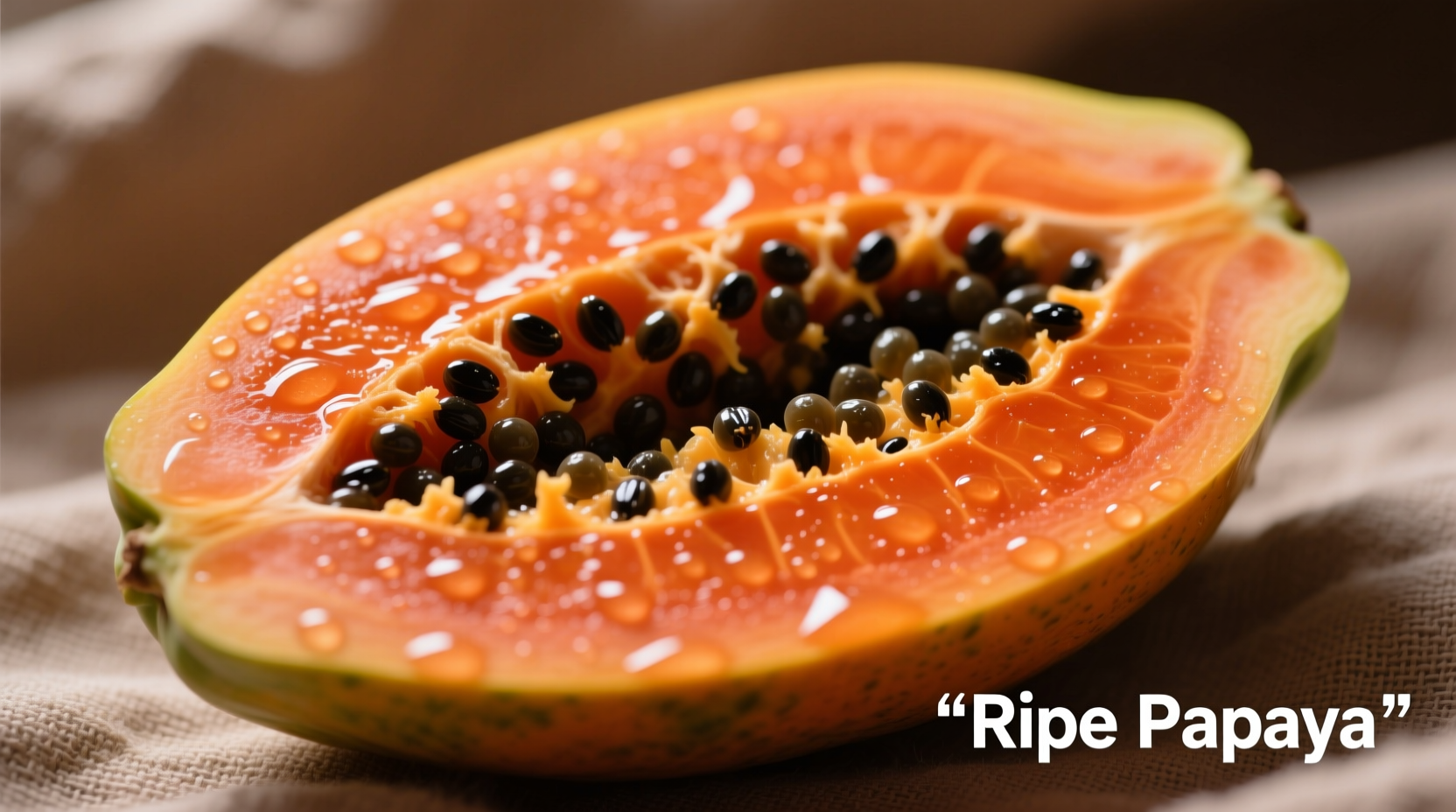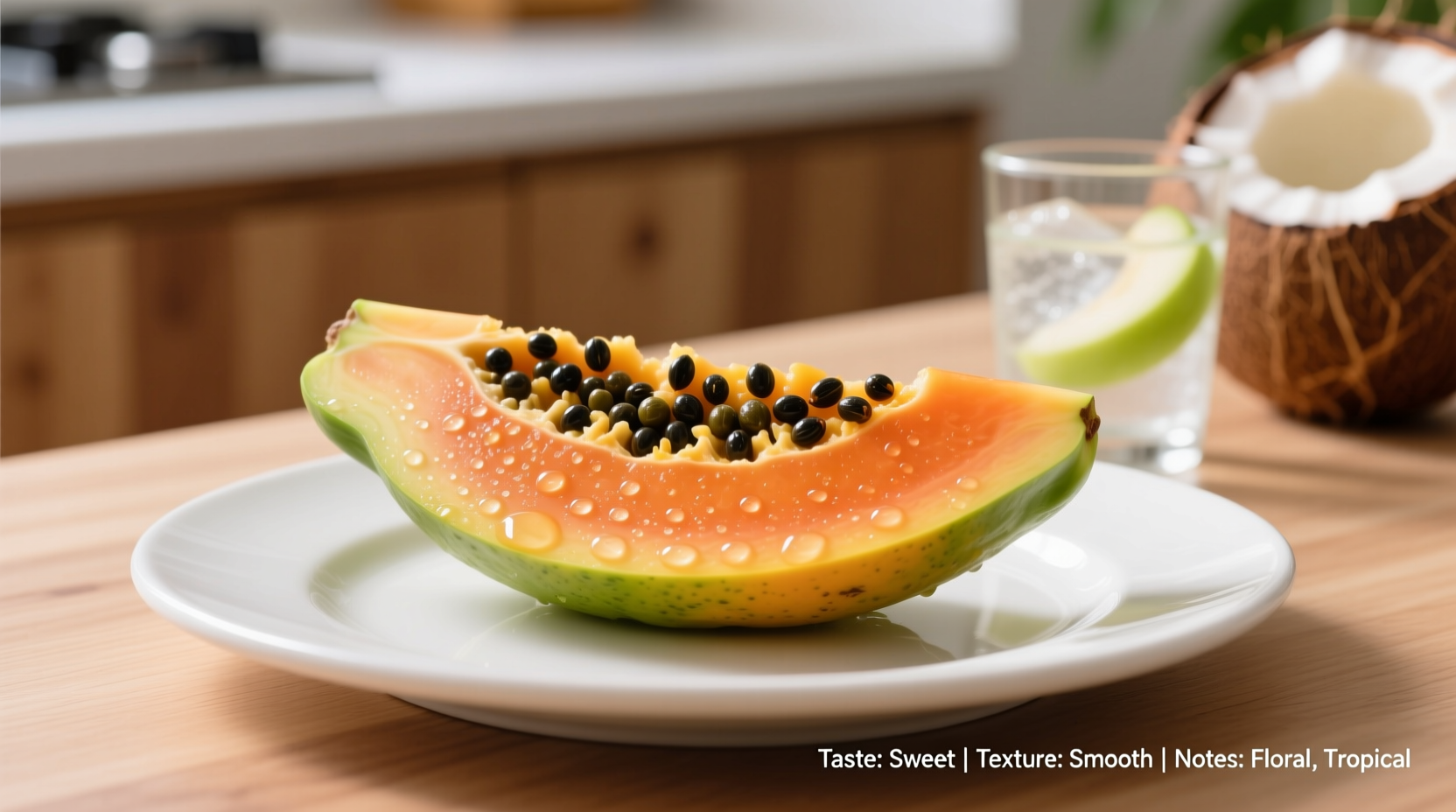If you've ever wondered what does papaya taste like, here's the direct answer: Ripe papaya offers a mildly sweet, tropical flavor with subtle notes of mango and cantaloupe, balanced by a distinctive musky undertone. The texture is soft and buttery, similar to a very ripe peach. Unripe papaya tastes completely different—bland, slightly bitter, and more vegetable-like.
Ever stood in the produce aisle holding a papaya, unsure if you'd enjoy its flavor? You're not alone. As Maya Gonzalez, our Latin American cuisine specialist with a decade of experience documenting indigenous fruit traditions, explains: "Papaya's flavor profile often surprises first-time tasters. It's not as intensely sweet as mango nor as floral as pineapple—it occupies a unique space in the tropical fruit spectrum."
Understanding Papaya's Flavor Journey
The taste of papaya transforms dramatically as it ripens. This evolution explains why some people love it while others find it off-putting—they've likely experienced it at different stages.
| Ripeness Stage | Taste Profile | Texture | Best Uses |
|---|---|---|---|
| Green (Unripe) | Mildly bitter, vegetal, cucumber-like | Firm, crunchy | Salads, curries, pickling |
| Turning Yellow | Subtle sweetness emerging, mild musk | Firm but yielding | Smoothies, fruit salads |
| Yellow-Orange (Ripe) | Sweet tropical notes, distinct musk | Buttery, soft | Eaten raw, desserts, salsas |
| Deep Orange (Overripe) | Intensely sweet, fermented notes | Very soft, almost mushy | Smoothies, purees, baking |
What Exactly Does Ripe Papaya Taste Like?
When perfectly ripe, papaya delivers a complex flavor experience that combines:
- Sweetness level: Moderate—not overwhelming like mango but noticeably sweet
- Primary notes: Hints of cantaloupe with subtle mango undertones
- Distinguishing characteristic: A musky, almost floral quality that sets it apart
- Aftertaste: Mildly earthy with a clean finish
"The muskiness often catches people by surprise," notes Gonzalez. "It's not unpleasant—think of it as papaya's signature note, similar to how banana has its distinctive flavor. Once you recognize it, you'll appreciate how it balances the sweetness." 
How Papaya Compares to Other Tropical Fruits
Understanding papaya's taste becomes easier when comparing it to familiar fruits:
- Mango: Papaya is less intensely sweet with more subtle flavor notes. Mango has bold tropical sweetness while papaya offers gentle complexity.
- Cantaloupe: The closest comparison—papaya shares cantaloupe's honeyed notes but adds tropical depth and that distinctive musk.
- Peach: Similar buttery texture when ripe, but papaya lacks peach's floral notes and has more tropical character.
- Pineapple: Papaya contains no tartness or acidity—its flavor profile is entirely sweet and mellow.
The Science Behind Papaya's Unique Flavor
Research from the University of Hawaii's College of Tropical Agriculture reveals that papaya's distinctive taste comes from specific compounds:
- Carotenoids: Responsible for the orange color and sweet, melon-like notes
- Thiols: Create the characteristic musky aroma (similar compounds appear in passion fruit)
- Low acid content: Explains why papaya lacks the tartness of many other tropical fruits
According to USDA nutritional data, papaya's sugar composition (primarily fructose with some sucrose) creates its gentle sweetness without overwhelming the palate.
Why Some People Dislike Papaya's Taste
Not everyone enjoys papaya, and there are legitimate reasons why what does papaya taste like varies by person:
- Ripeness issues: Eating unripe papaya (common mistake) delivers bitter, unpleasant flavors
- Sensitivity to musk: Some palates detect the musky notes as slightly fermented
- Cultural familiarity: People accustomed to stronger tropical flavors may find papaya too mild
- Genetic factors: Research from Monell Chemical Senses Center suggests genetic variations affect how we perceive certain fruit compounds
How to Choose and Prepare Papaya for Best Flavor
Maximize your papaya tasting experience with these professional tips:
- Selecting: Look for yellow-orange skin with minimal green. Gentle pressure should yield slightly.
- Ripening: Place unripe papaya at room temperature until skin turns yellow-orange (3-5 days).
- Preparation: Cut lengthwise, scoop out black seeds (they're edible but peppery), and remove any remaining stringy bits near the skin.
- Serving: Chill before eating. A squeeze of lime enhances the tropical notes without overpowering.
- Flavor boost: Sprinkle with a pinch of salt or chili powder to balance sweetness—a common practice in Mexican and Southeast Asian cuisine.
Culinary Uses That Highlight Papaya's Best Qualities
Understanding what does ripe papaya taste like helps you use it effectively in recipes:
- Fresh consumption: Enjoy with lime juice and mint for a refreshing breakfast
- Salsas: Combines beautifully with red onion, jalapeño, and cilantro
- Smoothies: Blends well with banana and coconut milk (masks any excessive musk)
- Desserts: Pairs with coconut, lime, and tropical spices like cardamom
- Salads: Adds sweetness to green salads with avocado and citrus dressing
"The secret to loving papaya," Gonzalez shares, "is treating it like cantaloupe rather than mango. Don't expect intense sweetness—appreciate its subtle complexity and how it complements other flavors."
Common Questions About Papaya Flavor
Before you try papaya, you probably want to know:
- Does papaya taste like melon? Yes, but with tropical depth—think cantaloupe's sweetness with subtle mango notes and a musky finish.
- Why does my papaya taste bitter? It's likely underripe. Fully ripe papaya should have minimal bitterness.
- Does papaya taste good with lime? Absolutely—the citrus enhances its tropical notes without overwhelming the delicate flavor.
- Why do some people say papaya tastes like vomit? This controversial opinion comes from sensitivity to the musky compounds, especially in overripe fruit.
Now that you understand what does papaya taste like at its best, you can make an informed decision about trying this nutrient-rich tropical fruit. Remember that proper ripeness makes all the difference—give it a chance when perfectly yellow-orange for the most enjoyable experience.











 浙公网安备
33010002000092号
浙公网安备
33010002000092号 浙B2-20120091-4
浙B2-20120091-4